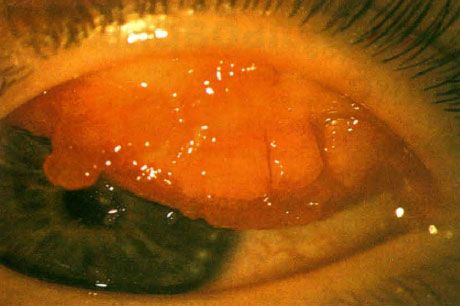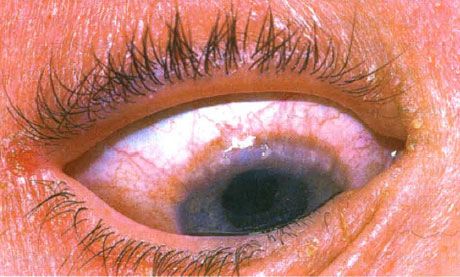Medical expert of the article
New publications
Spring conjunctivitis in children
Last reviewed: 07.07.2025

All iLive content is medically reviewed or fact checked to ensure as much factual accuracy as possible.
We have strict sourcing guidelines and only link to reputable media sites, academic research institutions and, whenever possible, medically peer reviewed studies. Note that the numbers in parentheses ([1], [2], etc.) are clickable links to these studies.
If you feel that any of our content is inaccurate, out-of-date, or otherwise questionable, please select it and press Ctrl + Enter.
Symptoms of spring conjunctivitis:
- redness of the eye;
- itching;
- lacrimation;
- swelling of the eyelids;
- mucous discharge.
Vernal inflammation of the conjunctiva of the eyelids
- Injection of the eyeball and conjunctiva of the eyelids, single follicles.
- Large "juicy" papillae on the conjunctiva of the eyelid cartilage.

Giant papilla in severe vernal conjunctivitis
When the cornea is involved in the pathological process, punctate epithelial opacities are localized in its upper third, showing a tendency to merge and form erosions. Subsequently, subepithelial scarring occurs. Epithelial erosions can merge, become covered with mucus, fibrin and cellular elements. So-called spring "plaques" are formed.
Limbal form of vernal conjunctivitis
- Swelling and opacification of the limbus with whitish precipitation (Trantas spots) around the entire circumference of the limbus.
- Vascular injection and arcuate lipid deposition in the limbal area.

Limbal vernal conjunctivitis. Trantas spots are visible
What do need to examine?
How to examine?
Treatment of spring conjunctivitis
An acute disease with pronounced symptoms. Steroid solutions (for example, prednisolone, fluorometalone) are prescribed in the form of drops and ointments. The drugs are used for no more than 1 month, and during this period the condition of the eye is closely monitored, conducting periodic tonometry. Disodium chromoglycate or lodoxamide is prescribed in the form of drops (3-5 times a day) or ointments at night. The effect of the therapy usually appears after a few days.
Decongestants and antihistamines play a certain role. Sometimes, under the cover of appropriate drug treatment, spring "plaques" are removed. Giant papillae usually regress with adequately selected therapy. Cold compresses are prescribed to relieve acute symptoms.
In chronic cases of vernal conjunctivitis, the use of steroid drugs is not indicated.


 [
[